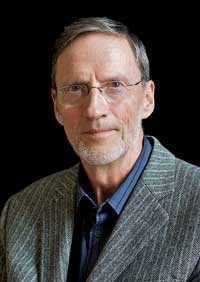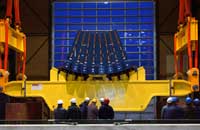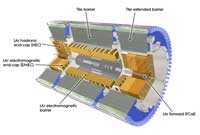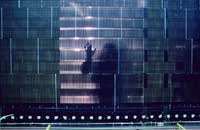Sven-Olof Holmgren: science education is more complex than particle physics Inspire article
Do you think particle physics is a complex subject? Having moved from basic research to science education, Sven-Olof Holmgren would disagree. He tells Lucy Patterson and Marlene Rau about the challenges of this shift, and about a major reform in the Swedish education system.

Image courtesy of Kajsa Kax
Wåghals
Sven-Olof Holmgren began his career as a particle physicist. He obtained his PhD in 1970 and a professorship from Stockholm University, Sweden, in 1992, where he also served as Head of the Physics Department for several years. During this period, Sven-Olof and his group worked on a number of big experiments, including several at CERNw1 in Geneva, Switzerland.
Involved in both the development of detectors and data analysis, they most recently worked on the ATLAS detector of the Large Hadron Collider (LHC). Sven-Olof’s group built the readout electronics for the tile calorimeter, which will collect the energy deposited by secondary particles in the proton-proton collisions. Of course, Sven-Olof is eager to see the results that the LHC will deliver: “After decades of preparation, this is the time to reap the reward.”
Since 1997, however, Sven-Olof’s interests have shifted to encompass science education as he became involved in the development of a science education programme by the Royal Swedish Academy of Sciencesw2 (KVA). He describes his transition into science education and the last 13 years with the KVA schools programme as among the most exciting times of his career. However, it has been “a bumpy road with ups and downs”, as Sven-Olof puts it. One of the big changes for him was coping with the shift in his research work from the pure science of physics to the social science of education. Now, he is even co-supervising a PhD student in science education.
“The change has opened up a whole new world for me and a new kind of research. I have spent most of my professional life working on hardcore, basic physics. But the way I see it now, physics is really the simplest of the sciences because we can really control our experiments.

down into the ATLAS cavern
Image courtesy of the ATLAS
Experiment at CERN
Take a pendulum, for instance: suspend a weight from a string, give it a push and measure the time it takes to swing from one end to the other – you will soon find out that its period is constant. You can then formulate a theory on what this may depend on – the mass or size of the weight, the length of the string, etc.; do controlled experiments, changing just one variable at a time, while keeping the others constant; and eventually you will find that the period depends on the length of the string only. There’s a consensus that scientific experiments should be done like that, under controlled conditions – and in physics, it’s relatively easy to do that – even complicated experiments such as the LHC are performed according to these principles.
“There is a kind of increase in complexity through chemistry and biology, until you get to the social sciences, which are about as complex as you can get. There, research is completely different. A theory in social science is not at all the same as a theory in science. It’s psychology – you have to take into account peoples’ way of thinking. Of course it’s called social science because one tries to apply scientific reasoning. But for me, many of the theories in social science, and indeed in science education, seem more like perspectives. You interpret your data from one perspective and even design your study from that perspective. However, someone else could come along and see the same thing from a very different angle. So you can have several different theories running in parallel and it’s very hard to see the development. It’s very difficult to prove that one theory is better than another because it’s all so complex. This is something we natural scientists have to get used to – and I think we have been criticising each other far too often.
“In education science you don’t have just one individual – you have a class of thirty or so students and a teacher, all interacting with one another – it’s a very complex system. There have been attempts to directly compare two ways of teaching the same science subject – in an inquiry-based versus a traditional setting: the researchers didn’t find much of a difference. Yet they mostly evaluate the results in terms of how much of the subject matter was conveyed. In terms of the students’ or teachers’ motivation or enthusiasm for science, which are important in the inquiry-based approach, there might well have been a difference.

of the ATLAS calorimeter.
Click to enlarge image
Image courtesy of the ATLAS
Experiment at CERN
“Personally, I believe that we have been concentrating solely on the knowledge of the subject matter for too long. We should not only be teaching the results, but also how they are achieved – how science is done. This is often lacking not only in school but even at the undergraduate university level, and I think it’s high time for a paradigm shift. Then again, this is of course also another perspective, and possibly difficult to prove.”
Since moving into education, Sven-Olof has witnessed a shift in attitudes towards science education and teaching in general in Sweden – an interesting time for him to hone his new skills. “In the past, science teaching in Sweden at primary level was rather more haphazard. This all changed gradually, culminating in 1994 with the introduction of major reforms in the Swedish education system, including new National Standards. These defined certain ‘goals to achieve’ and ‘goals to strive for’ that would have to be met by grades five and nine. Crucially, however, it didn’t prescribe exactly how to reach them. This handed back control to local municipalities, schools and teachers who are now expected to design exactly what gets taught when, using their best professional judgment. At the same time, de-centralising control over the schools’ economy and education policy – which was also handed over to the local municipalities – has helped to create a real bottom-up education system.”

instrumentation of the barrel
tile calorimeter at CERN
Image courtesy of the ATLAS
Experiment at CERN
In Sweden, students attend nine years of compulsory school (Grundskola), after which there are three years of optional secondary school. With educational targets in science subjects that have to be met by grade five (age 11), the reforms mean that the planning to reach these goals has to start from grade one (age 7). Inspiration for the new National Standards was taken from ongoing work in other countries, particularly at the National Academy of Sciencesw3 in the USA. This work called for a new science education strategy. Sven-Olof himself has been involved in the development of a new science education programme called NTAw4 (Natural science and Technology for All; see box).
Sven-Olof agrees that the best time to introduce science to children is at primary school, while students are still trying to understand the world for themselves. “By the time children are about five or six, they have already pieced together a basic model of how the world works, based on intuition. However, this model is very limited because our senses are very limited. Science challenges this model: when you start to measure the world in a scientific way, you find it doesn’t fit the basic intuitive model anymore. So again you have to revise and refine your model. You then make more detailed experiments that challenge even the improved model, and so on…. And we never get more out of it than when we see a flaw, because then we have to revise the model.
“For me, science literacy is about getting beyond that first model we develop based on our senses – it’s about challenging our intuition and accepting ideas that might seem counter-intuitive concepts.”
And as far as Sven-Olof is concerned, the need for science literacy is even greater for the coming generations. “We’re facing a big problem today. If you ask 15-year-olds, they’re very keen to discuss societal problems like climate change, sustainable development and changing values, but they often lack the scientific basis to understand and tackle these issues. We are not talking about science for specialists and researchers – this is science for everyone. And that, to my mind, is what we really need. Science literacy will be really essential to understand the alternatives and make the right decisions. For me, in the end it’s a question of democracy and even of the future of this planet.”
The Swedish NTA programme
In 1997, the Royal Swedish Academy of Sciencesw2 (KVA) and the Royal Swedish Academy of Engineering Sciencesw5 (IVA) began to develop a new inquiry-based science education programme for primary and secondary schools, which became known as NTA: ‘Natural science and Technology for All’w4. As a member of the KVA, Sven-Olof became involved in the project early on and currently chairs the development group.
The NTA scheme comprises a series of themed units for primary and lower secondary school, covering different topics from the areas of biology, chemistry, physics and technology (e.g. ‘floating or sinking’ or ‘plant growth and development’), along with all materials and specific training for teachers. Following its initial success, the NTA program is steadily growing and being taken up by an increasing number of schools and municipalities across Sweden. The latest counts (Spring 2010) include 96 000 students and more than 7 000 teachers. In addition, KVA organises ‘teacher inspiration days’, where members of the Academy talk about their research to science teachers; and they award annual prizes for teachers’ biology, physics, chemistry and mathematics projects.
Web References
- w1 – For more information about CERN, the European Organization for Nuclear Research, see: www.cern.ch
- w2 – To find out more about the Royal Swedish Academy of Sciences, see: www.kva.se
- w3 – Learn more about the US National Academy of Sciences here: www.nasonline.org
- w4 – For more information about the ‘Natural science and Technology for All’ programme, see: www.nta.kva.se
- w5 – Find out more about the Royal Swedish Academy of Engineering Sciences here: www.iva.se
- w6 – The Rocard report, with proposals for widening European educational approaches to science, can be downloaded from the European Commission website (http://ec.europa.eu) or via the direct link: http://tinyurl.com/2mjrd7
Resources
- To learn more about the Large Hadron Collider at CERN and the particle physics involved, see:
- Landua R (2008) The LHC: a look inside. Science in School 10: 34-45. www.scienceinschool.org/2008/issue10/lhchow
- Landua R, Rau M (2008) The LHC: a step closer to the Big Bang. Science in School 10: 26-33. www.scienceinschool.org/2008/issue10/lhcwhy
Review
Physics is an exact science, using clearly articulated and universal laws and quantitative methods in research. By testing hypotheses, it seeks to make accurate predictions. Unlike physics, science education is a complex field, dominated by a series of psychological and social theories, some running in parallel. In this article, Sven-Olof Holmgren describes his career shift from research in particle physics to science education.
For science teachers, it will also be stimulating to read about an educational reform which made science compulsory from grade one. The Swedish NTA programme shows foresight by being based on inquiry-based learning. The reform is thus aligned with the Rocard report, Science Education Now – a Renewed Pedagogy for the Future of Europew6.
The article can be used in the classroom to stimulate a discussion of the relations between science and science education.
Niels Bonderup Dohn, Denmark





